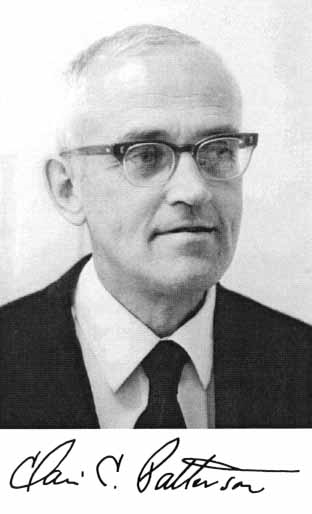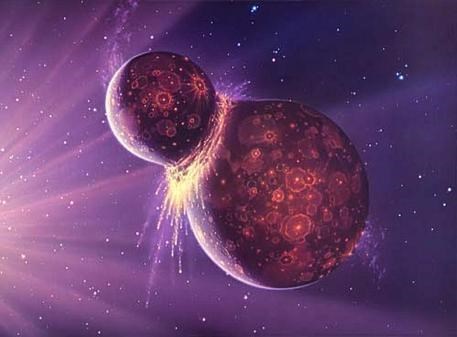 |
| (data.desmoinesregister.com) |
As the American author, Og Mandino, wrote, "Failure will never overtake me if my determination to succeed is strong enough" (Mandino). Clair Patterson's scientific work proves this quote; his hard work led him to radically change our understanding of science forever. Patterson was born on June 2, 1922 in Des Moines, Iowa. He married Lorna McCleary at 22, in 1944, and they had four children together. "Much of Patterson's professional career was spent as a research associate of environmental science at California Institute of Technology (Caltech) until his retirement in 1992." He died on December 2, 1995, in his house in The Sea Ranch, California ("Clair Patterson"). A hero must always push the boundaries of people's thinking and strive to achieve, where others give up or fail. His groundbreaking work and belief in the scientific has literally saved the world. Clair Patterson was a hero because he strived to make life better, answered scientific questions, dedicated his life and his time to his field, and revolutionized modern science.
 |
| (www.nap.edu ()) |
Clair Patterson embodies heroic qualities through his desire to improve all people's lives and discover more about the world. He insisted on the truth, even when the truth went against the conventional wisdom of the time. One example is when Patterson discovered something new while analyzing prehistoric samples: "He maintained that the belief arose from the poor quality of lead analyses in prehistoric comparison samples in which much of the lead reported was actually due to underestimation of blank contamination. He compiled the amounts of industrial lead entering the environment from gasoline, solder, paint, and pesticides. He estimated the lead concentration in blood for many Americans to be over 100 times that of the natural level, and within about a factor of two of the accepted limit for symptoms of lead poisoning to occur" (Tilton). Lead is now a well-known poison to the human system. The downfall of the Roman Empire has been attributed to the lead they used to sweeten their wine. Infants exposed to lead exhibit developmental delays and mental retardation. However, the petroleum companies declared leaded gasoline "safe". Even when Patterson was threatened and discredited by big oil, he stood by his facts based on the scientific method. He first raised the alarm about the dramatic increase in lead contamination in the environment from the lead in gasoline (Kitman). Patterson revolutionized lab procedures to prevent contamination of lead in experiments which helped in many scientific discoveries. Previously, in labs, there was not adequate screening to keep out lead contaminations, so all the research samples were tainted with lead sources, namely gasoline, pesticides, and paint. These discoveries later caused major changes in the gasoline industry as well, because he caused gasoline to become unleaded -- something people nowadays take for granted. Furthermore, Patterson discovered a entirely new field in science: "That was possible only after he had spent some five years establishing methods for the separation and isotopic analysis of lead at microgram and sub-microgram levels. His techniques opened a new field in lead isotope geochemistry for terrestrial as well as for planetary studies" (Tilton). Through his hard work in eliminating lead contamination, Patterson created an undiscovered scientific field. This new knowledge of isotopes completely changed how scientists look at the universe, and by using his techniques we can study other planets. His studies also led him to use lead isotope geochemistry to find out the earth's age. His work changed how society views everyday items, and caused people to question the "Sound Science" that we used to believe.
Patterson also embodies the spirit of a true hero with his dedication and determination, no matter what others say or believe. Tilton writes about how Patterson had been rebuked for his work, however he persisted: "Patterson's participation did not stop; instead on October 27, 1965, he wrote to California Governor Pat Brown restating the points from his 1965 review and emphasizing the dangerously high levels of lead in aerosols, particularly in the Los Angeles area. In it he claimed that the California Department of Public Health was not doing all it should to protect the population from the dangers of lead poisoning. His first request drew a polite rejection. A second letter on March 24, 1966, had better success ... to hold hearings and to establish air quality standards for California by February 1, 1967" (Tilton). His persistent lobbying to the governor first fell on deaf ears, however after repeated tries, he caused a movement for the air quality. Where some might have given up on a seemingly was pointless cause, Patterson strived to improve the lives of everyone. Similarly, Patterson showed his determination and willpower when this happened: '"Another leading toxicologist had just returned from a World Health Organization conference where fifteen nations had agreed that environmental lead contributions to the body burden had not changed in any significant way, either in blood or urinary lead contents, over the last two decades. He called Patterson's conclusions "rabble rousing"' (Tilton). Despite the toxicologists and the World Health Organization's disapproval of his results, he persisted, and moved forward with his discoveries. His results showed that the lead concentration in humans was as much as hundreds of times more than it was thousands of years ago. His persistence and dedication to his field eventually paid off, and now he is remembered for his dedication, persistence, and a knack for discovery.
 |
| (www.redshift-live.com ()) |
Patterson shows heroism in how he revolutionized the scientific community with his new way of thinking. Patterson's detailed work led to an accurate age of the earth that has remained mostly unchanged: "Patterson determined the earth to be about 4.6 billion years old" (Claire Patterson). He changed how we see the earth today; rather than a young planet, reaching adulthood, it is a old planet, and we now know it is almost as old as the sun. Also this discovery sparked scientific interest, which inspires a new generation of explorers. Furthermore, while this number may seem like an unimportant value, this value is key to many sciences, and has changed quite a bit from the previous estimate: "The new age was substantially older than the commonly quoted age of 3.3 billion years, which was based on tenuous modeling of terrestrial lead evolution from galena deposits" (Tilton). This new value shaped biologists time scale of evolution. Furthermore his discovery had repercussions in the field of geology. This shift in thinking let the world know more about where we came from and also inspired others to discover more.
By persevering, and sticking to his goals. Patterson was able to broaden the world of science. Not only did he discover the true age of the earth, but also he made the community as a whole safer by the removal of lead in common products such as paint, gas, and pesticides. His work inspires me now just the same way as it did when I first watched "Cosmos; A Space Time Adventure (2014)". I am in awe of how an ordinary human being could shape our world so much, and it shows me, that everyone can be a hero, with enough hard work and dedication. His incredible work ethic and adventurous spirit lead society into this age where we are aware of our surroundings and question what others tell us. Remember Clair Patterson, the incredible discoverer, the unsung hero, the greatest human that you never knew existed. Whether it be when we go down the road to get a fill up, when a tractor lifts up dirt that has been around for millions of times longer than we have, or when we stare in astonishment at the stars. Think about Clair Patterson, the dedicated hero, who shaped our world.
Works Cited
"Claire Patterson." Notable Scientists from 1900 to the Present. Ed. Brigham Narins. Detroit: Gale, 2008. Biography in
Context. Web. 1 May 2015.
"Clair Patterson." World of Chemistry. Gale, 2006. Biography in Context. Web. 30 Apr. 2015.
Dicke, William. "Clair C. Patterson, Who Established Earth's Age, Is Dead at 73." The New York Times. The New York
Times, 07 Dec. 1995. Web. 01 May 2015
Kitman, Jamie Lincoln. "The Secret History of Lead." The Secret History of Lead. The Nation, 20 Mar. 2000. Web. 18 May
2015.
Kramer, Miriam. "'Cosmos' Recap: What Lead Poisoning and Earth's Age Have in Common."Cosmos Recap. Space.com, 21
Apr. 2014. Web. 04 May 2015.
Mandino, Og. "Og Mandino Quote." BrainyQuote. Xplore, 2001. Web. 14 May 2015.
Tilton, George R. "Donald F Nelson 1922-1995." Science & Justice 35.4 (1995): 319. Clair Cameron Patterson. National
Academy of Sciences, 1998. Web. 5 Oct. 2015.
Page created on 5/31/2015 12:00:00 AM
Last edited 1/9/2017 9:17:54 PM
